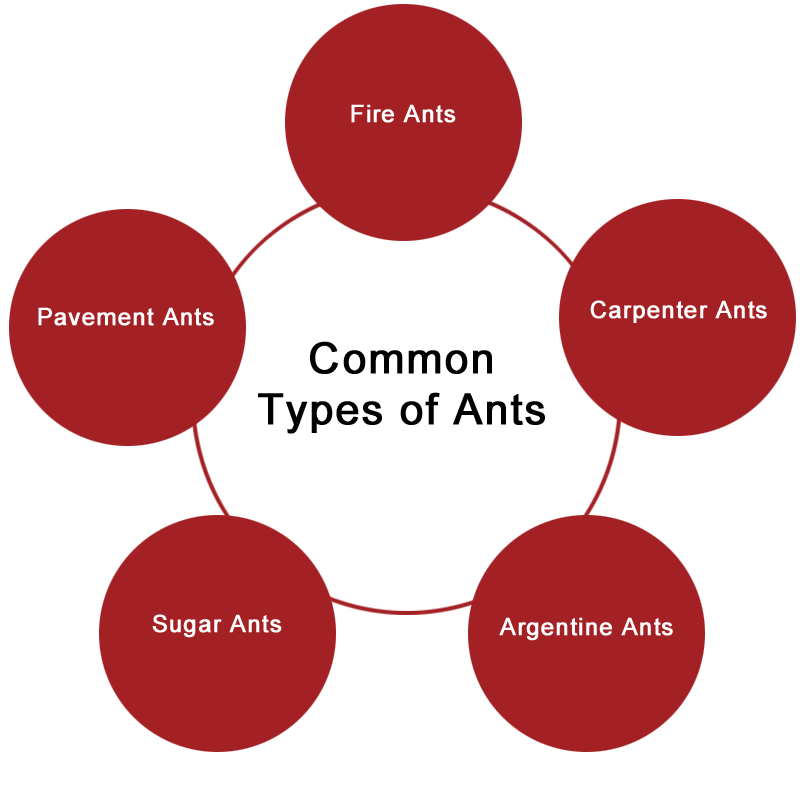
While an ant problem is best left to the professionals if left unchecked, resolving these issues on your own is possible, particularly if caught early. If you are planning on treating your home for ants, you may want to first educate yourself on methods that eliminate ants without posing a safety or health hazard to yourself or your family. The following will give you some pointers and strategies that will eliminate ants safely, based on methods we use at Sloan Pest Control.
Ants are more than just a simple nuisance. Their presence can lead to the spread of diseases such as Salmonella and E. coli in your home through food contamination. As they spread, they can cause damage to your home’s electrical systems as well as its structure. And where there are ants, there could be more insects and possible rodents, only exacerbating your pest problem.
In order to properly treat for ants, ridding your home of these invaders, you need to understand them. This means knowing why they’re in your home, where you can find them hiding, how they found their way in, and how you can remove them.
Why Ants Invade Your Home
Like any living creature, ants are driven by the need for food, water and shelter.
The sustenance they seek isn’t just found in your pantry. They require sugar for energy, and they find it in syrup, soda, or fruit juice spills left uncleaned. They need protein and fat to feed their young, and they find it in meats, cheeses, and oily foods that are left unprotected. And they need water. Not a lot; the condensation from poorly insulated homes, the slow leak of a pipe or the moisture in a damp towel could be all they need.
Essentially, your home offers everything they need to survive. And with their keen sense of smell, they can track scent trails to the source over massive distances, let the rest of the colony know what they’ve found, and come back with reinforcements. This sense of smell, powered by a sophisticated olfactory system located on their antennae, are part of how ants are uniquely suited to adapt and survive any conditions.
Which is great for them, but bad for homeowners trying to keep them out.
Common Types of Ants in Georgia
Below is a list of common types of ants that people often encounter in Georgia, the foods that these ants are attracted to, and the dangers of each ant:

• Fire Ants (Solenopsis invicta): Attracted to proteins and fats, they prefer meat scraps and greasy foods. The danger lies in their stings, which are painful and can cause allergic reactions.
• Carpenter Ants (Camponotus spp.): They’re drawn to sweets and proteins such as honeydew, sweets, and meats. Although they don’t pose a direct threat through stings or bites, they can cause structural damage to wood.
• Argentine Ants (Linepithema humile): These ants are fond of sweet substances like sugar and honeydew. They are more of a nuisance due to their persistent invasions into homes and gardens than a danger.
• Sugar Ants (Tapinoma sessile): Known for their attraction to sugary foods such as honey and syrup. They are not dangerous as they do not bite or sting, but they can contaminate food sources.
• Pavement Ants (Tetramorium caespitum): They eat a variety of foods, including seeds, meats, and sweets. These ants can bite but are generally not harmful to humans.
• Ghost Ants (Tapinoma melanocephalum): Prefer sweet kitchen foods and honeydew. They pose no significant danger since they do not bite or sting, but they can be a nuisance in the home.
Finding Where They’re Hiding
Once ants have found a ready supply of food and water, they will begin establishing nests in tucked-away spots all over the home. Separate from the main colony, these nests give them a foothold in your home that can make them difficult to dislodge. A few common hiding places for ants include:

• The Kitchen: With plenty of available food and water, your kitchen is generally an ant’s primary target. Keeping everything clean, sealing food in plastic, and quickly addressing spills are key to keeping the kitchen secure.
• The Bathroom: The ant’s sense of smell can draw it toward scented body washes or shampoos, inviting them into a room where moisture and water are abundant. Keep everything clean and dry to keep them out.
• Inside Your Walls: One of ant’s favorite hiding places is within the walls, where they can’t easily be reached. Check for cracks or damaged spots that would give them easy access.
• Pet Dishes: The crumbs and water left behind by your pets are very attractive to ants. Keep the area around your pet’s water and food dishes clean or create a barrier around them using petroleum jelly as a deterrent.
• Other Rooms: From bedrooms to living rooms, any area in which people might eat is an area where they might leave crumbs, attracting ants. Regular cleaning, including vacuuming, are vital to reducing infestation risk.
• HVAC Systems: By creating spaces for shelter as well as providing water through condensation, your heating and air conditioning systems can make ideal spots for ants to hide.
• Beneath Concrete Slabs: One of the most difficult areas to dislodge ants from, concrete slabs provide ideal shelter for nests and even entire colonies.
Following the ants’ trail could lead you back to where they’re hiding. Once you’ve eliminated them there, it’s time to find out how they got in.
Sealing Off Entry Points
Just as regular cleaning and maintenance inside can make your home a less inviting place for ants to seek out food, water and shelter, keeping up with your exterior can play a role in keeping ants out. In the yard, tidy up any wood piles which can give ants a stronghold just outside your walls and keep bushes trimmed. Look for any cracks around the foundation, as well as windows and doors, and seal any that you find with silicone caulk. Finally, a perimeter treatment of insecticide can act as an extra layer of protection against intrusion.
Another sign that ants have established a beachhead outside your home is the presence of ant mounts. Yards that have an abundance of food sources, from spills and crumbs to decaying organic matter, are attractive to ants, who establish colonies where they can breed, store food and reproduce. They are also drawn to the nectar or sap of certain plants, moist soil and hiding places such as leaf piles. Natural repellants and regular maintenance can deter ants, while natural predators from birds and frogs to other insects can help fend them off.
Eliminating Ants Inside
Once you’ve reduced the readiness of food, water and hiding places and prohibited further ants from getting in, it’s time to get rid of those ants already inside. We recommend using Integrated Pest Management (IMP) approved ant control products, which are available at most hardware stores. Apply sparingly for the safety of children and pets, and take photos and notes to track your progress. Requesting IPM-approved insecticides when shopping is essential for safeguarding the environment, protecting human and animal health, and ensuring the long-term success of pest control methods. These products aim to reduce damage to unintended species and combat the development of pest resistance, thereby endorsing sustainable and conscientious approaches to pest management. Opting for IPM-approved insecticides helps preserve a more robust ecosystem and promotes a safer habitat for both today’s and tomorrow’s communities.
Eliminate Ants Outside
Another remedy besides an IMP approved insecticides that may be effective is Diatomaceous Earth (DE), a powder made from the remains of diatoms, which are tiny aquatic organisms. This powder repels ants, so sprinkling a line of it around entry points and areas where ants are present can help contain them. You can potentially get similar results from cinnamon, vinegar, chalk or baby powder. Other natural remedies include Bay Leaves, which pack a strong aroma that repels ants and can be placed throughout the house, as well as essential oils like tea tree, citrus or peppermint. Diluting a few drops in water creates a highly effective ant repellent spray.
Ants tend to build mounds in yards that offer ample food and few natural threats. To disrupt this pattern, you might create a habitat rich in variety: incorporate bird feeders, indigenous vegetation, and water features such as birdbaths or ponds. Designate parts of your garden to remain untamed, with natural shelters like rocks and logs for reptiles, and use fewer pesticides to safeguard these advantageous species. Cultivating a diverse garden with reduced lawn space encourages a healthy insect ecosystem, which in turn attracts predator species that feed on ants.
Lure Ants Away from Their Ant Mounds
To humanely direct ants to a new location, establish a path using specific foods: meat or pet food for Fire Ants, jelly and peanut butter for Carpenter Ants, syrupy mixtures for Argentine and Sugar Ants, and oily substances like bacon grease or sweet items for Pavement and Ghost Ants. Implement these food trails to lead the ants to a preferable area, while being cautious to prevent ant bites. Consistently inspect and modify the trail as necessary. This humane method’s success will vary with the specific ant species and the size of their colonies.
Other Outside Tactics to Get Rid of Ants:
To naturally keep ants away from your home, use natural repellents like vinegar, cream of tartar, cinnamon sticks, coffee grounds, chili pepper, paprika, cloves, dried peppermint, lemon juice, or garlic as barriers. Another effective strategy is to plant mint around your home’s foundation. Moreover, distributing coffee grounds, cayenne pepper powder, or cinnamon around ant mounds in your yard can encourage the ants to vacate the area.
These are just some off-the-beaten-path tactics to deal with ants. They are not scientifically proven tactics by any means. The formulas that experienced Integrated Pest Management technicians use are far more effective and longer-lasting than those listed above. The real science of keeping ants away is to not provide an ideal place for them to live in your yard, nor any food or water for them to survive on. It’s that simple. Now, if you are experiencing an infestation of ants, the unconventional ways above may not work for the long-term.
If All Else Fails, Contact Sloan Pest Control
If these preventative measures aren’t enough to rid your home of ants, Sloan Pest Control is ready to serve with our Pest Control Promise. We use the principles of IPM to quickly address ant infestations while minimizing health hazards to you, your family and your pets. This approach is more than just spraying for ants, integrating a variety of preventative methods from sealing off entry points to addressing moisture issues.
Call today for a free inspection and put Sloan Pest Control’s Pest Control Promise to work. If the ants return, so will we, free of charge.


